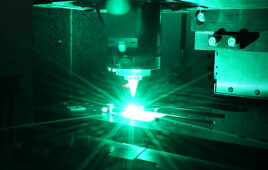Although manufacturing is fundamental to a medical device’s success, its influence is often not taken into account during development. This article covers four areas affected by manufacturing that every design engineer should consider in their next project.
Del Lawson and David Franta, 3M

Manufacturing’s influence spans the entire development process. (Image courtesy of 3M)
Not every medical device idea makes it to production, and manufacturing is often not considered early enough in development to help ensure this stage’s success. Why is it not prioritized sooner?
The exact answer might be different for each project. Manufacturing’s influence spans the entire development process. The sooner teams start thinking about its potential implications, the more robust the design will be. Here are four areas worth addressing early in the development process.
Material selection for performance
It can be challenging to know if you are prioritizing the right factors in material selection. Development teams typically prioritize how the device will look and function. Yet, these considerations cannot come at the expense of selecting materials that are incompatible with each other (if the device will have multiple layers) or with your desired manufacturing process. For example, not all materials are compatible or can withstand high speeds, friction or heat.
To determine material compatibility, examine each option’s mechanical and chemical properties to determine if there are potential sources of contamination from one layer to the next and whether they exist naturally or result from a different part of the development process.
In determining material compatibility with your manufacturing process, work to ensure your process is truly attuned to your device. Test more than one lot of production-equivalent material and your device’s critical raw materials. Critical raw materials should relate to the final product’s design specifications. Their influence affects your product’s ability to meet regulatory, safety, efficacy and appearance needs.
The best way to know if your materials are compatible with your process is to test a near-final version of your product — something beyond a rough prototype. Your material supplier can help vet, test and prevent potential issues. Bring them into the development process as soon as you can to help you select the best materials.
Deciding on a sterilization method
Specific sterilization methods may alter how some materials perform. Gamma radiation, for instance, can stiffen and degrade polypropylenes. Changes caused by sterilization could affect how materials perform during and after manufacturing.
Consider how the sterilization method’s temperature and duration could alter each of the device’s components. Whether the device will be sterilized in its package can also affect its outcome and performance. Discussing the potential impacts in advance can help refine which materials are best suited for the project.
Environmental implications
The manufacturing plant’s temperature and humidity — which may change with the seasons — can affect device performance. For instance, hydrophilic materials can be vulnerable to degrading over time due to exposure to moisture.
If your product will experience those changes during manufacturing, ask your manufacturing partner and material supplier about incorporating different process controls and standards.
Controlling costs
Manufacturing directly influences the end product’s price. Equipment, labor and raw materials are all contributing factors. To help keep long-term costs down, develop a robust, repeatable process capable of running with different operators.
Occasionally, development teams attempt to save costs by using the most inexpensive materials without considering compatibility with the manufacturing process. While material costs must be considered, material performance and total cost to produce should be a top priority. If incorporating a higher-cost material allows your manufacturing process to run more efficiently, your total product cost may be lower.
To learn more about the potential impacts of manufacturing throughout device development, download, “A design engineer’s guide to manufacturing challenges: Finding balance between design, material & production.”
Del R. Lawson leads new product development and commercialization for 3M’s Medical Solutions Division. He has over 25 years of experience at 3M in laboratory management, strategic product platform creation and Lean Six Sigma operations, working on the development of advanced analytics and sensors, biotechnology solutions and medical adhesives.
David Franta leads the Microfluidics Global Business in 3M’s Medical Solutions Division. He has more than 25 years of experience at 3M in product and process development, business management strategic product platform creation and Lean Six Sigma, and in creating biomedical sensors, biotechnology solutions and medical adhesives.
The opinions expressed in this blog post are the author’s only and do not necessarily reflect those of Medical Design and Outsourcing or its employees.




